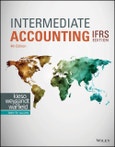Essential knowledge of International Financial Reporting Standards for students of global accounting
This important work provides the tools global accounting students need to understand international financial reporting standards (IFRS) and how they are applied in practice. This text emphasizes fair value, proper accounting for financial instruments, and new developments in international accounting. By presenting IFRS in light of current accounting practice, this book helps students gain practical knowledge of the topic that they can apply as they advance into their global accounting careers.
With this revised and updated Fourth Edition, students will develop a firm conceptual understanding of IFRS, as well as the ability to integrate their learning through practical exercises. Throughout this text, Global Accounting Insights highlight the important differences that remain between IFRS and U.S. GAAP, discussing the ongoing joint convergence efforts to resolve them. Comprehensive, up-to-date, and accurate, Intermediate Accounting IFRS includes proven pedagogical tools designed to help students learn more effectively.
- Comprehensively covers the latest International Financial Reporting Standards and how they are applied in practice
- Takes a comparative approach to help students understand the differences between IFRS, U.S. GAAP, and other important standards
- Emphasizes practical application of knowledge with end-of-chapter Review and Practice sections
- Provides authoritative references and citations to ensure content reliability and provide opportunities for further study
- Includes access to video walkthroughs, interactive content, and digital resources to support student engagement and ensure positive learning outcomes
As IFRS gains broad acceptance around the world, students of global accounting will need to be intimately familiar with these standards, and prepared to keep up with the rapid changes in the international environment. Intermediate Accounting IFRS answers to these pressing needs, making it the clear choice for accounting courses at the intermediate level.
Table of Contents
1 Financial Reporting and Accounting Standards 1-1
2 Conceptual Framework for Financial Reporting 2-1
3 The Accounting Information System 3-1
4 Income Statement and Related Information 4-1
5 Statement of Financial Position and Statement of Cash Flows 5-1
6 Accounting and the Time Value of Money 6-1
7 Cash and Receivables 7-1
8 Valuation of Inventories: A Cost-Basis Approach 8-1
9 Inventories: Additional Valuation Issues 9-1
10 Acquisition and Disposition of Property, Plant, and Equipment 10-1
11 Depreciation, Impairments, and Depletion 11-1
12 Intangible Assets 12-1
13 Current Liabilities, Provisions, and Contingencies 13-1
14 Non-Current Liabilities 14-1
15 Equity 15-1
16 Dilutive Securities and Earnings per Share 16-1
17 Investments 17-1
18 Revenue Recognition 18-1
19 Accounting for Income Taxes 19-1
20 Accounting for Pensions and Postretirement Benefits 20-1
21 Accounting for Leases 21-1
22 Accounting Changes and Error Analysis 22-1
23 Statement of Cash Flows 23-1
24 Presentation and Disclosure in Financial Reporting 24-1
Appendix A Specimen Financial Statements: Marks and Spencer Group plc A-1
Appendix B Specimen Financial Statements: adidas AG B-1
Appendix C Specimen Financial Statements: Puma Group C-1
Company Index I-1
Subject Index I-3








